Research
Outline

We investigate the internal structure, origin, and evolution of the Earth and planets based on the experimental and theoretical research on Earth and planetary materials.
Our research covers the fields of experimental petrology and mineral physics, and our aim is to clarify the macroscopic view of the earth's and planetary phenomena based on the microscopic properties of the Earth and planetary materials.
Research Topic

Stability of high pressure phases, partitioning of elements at high pressures, and constitution of the mantle and core.
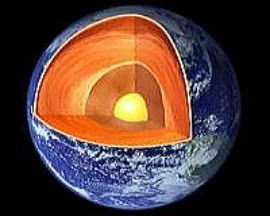
Metal-silicate reactions and origin of D" layer of the core-mantle boundary.

NASA
Physical properties of magmas at high pressure and temperature: density and viscosity of magmas: In situ X-ray determination of the viscosity of magmas.

our solar system
NASA
>Internal structure and evolution of terrestrial planets, icy satellites, and parent bodies of meteorites in the solar system.

Origin and formation of the Earth: magma ocean and core formation of the Earth, and Komatiite fenesis.
Facilities
High pressure and temperature experiments
Kawai-type multiunvil apparatue
* 3000 ton press
* 1000 ton press
* 700 ton press
* 1500 ton press
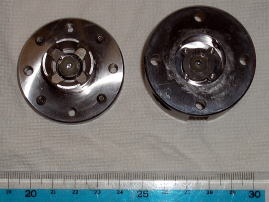
Diamond anvil cell
* Laser heating diamond anvil cell (~200Gpa, 2000K)
*External heating diamond anvil cell (~150Gpa, 1000K)

Laser Raman spectroscopy
(JASCO NRS-2000)
This device can measure inelastic scattering light (Raman scattering) excited by a laser beam illuminating on a material. Te wave number of Raman scattering (Raman shift) depends on the atomic combined state in the material. We use this device for identifying high-pressure polymorphs and determining pressure condition (Ruby fluorescence method) with the principle.
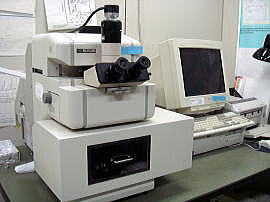
Micro-FITR apparatus
This device can collect infrared absorption spectra of samples. We use FT-IR to measure a water content of minerals.
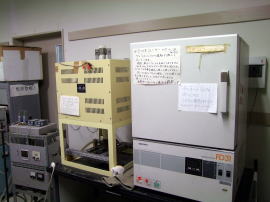
Electric furnaces
This device can synthesize a starting material for high-pressure and high temperature experiments.
1.jpg)
Micro focus X-ray diffractometer
(MAC Science M18XHF-SRA)
This device can take X-ray diffraction patters from a very small amount sample. We use this device for identifying constituent minerals of synthetics recovered from multi-anvil or diamond anvil cell high-pressure and high-temperature experiments.
11.jpg)
Scanning Electron microscope
(Hitachi S-3400N: Public Use Device)
This device scans a sample surface with electron beam. We can observe the sample shape and the difference on chemical composition in the sample based on secondary electron beam or back-scattered electron (BSE) beam excited by the scanning electron beam. We can observe a sample without any coating because BSE mode is available under low-vacuum condition. We can measure its chemical composition with energy dispersive spectroscopy (EDS) system attached to the electron microscopy. We can also study crystallographic orientation with electron backscatter diffraction (EBSD) system and defect and impurity in a crystal with Cathode luminescence (CL) detector.

Wavelength Dispersive Electron Probe Micro-Analyzer
(JEOL JXA-8800M: Public Use Device)
This device scans a sample surface with electron beam. We can observe the sample shape and the difference on chemical composition in the sample based on secondary electron beam or back-scattered electron beam excited by the scanning electron beam. In addition, we can measure its chemical composition with wave-length dispersive spectroscopy (WDS) system attached to the electron microscopy. WDS system allows us to get more accurate chemical composition than those obtained with EDS system.
3.jpg)
RF Sputtering device
(SANYU SVC-700RF1)
This device can make a deposition on a sample through sputtering of a metal or compound induced by radio frequency radiation power.
3.jpg)
Argon Ion milling device
(FISCHIONE MODEL 1010)
This device can prepare an ultra thin slice (thickness <~10nm) for TEM observation. We can hinder argon ion beam damage to a sample during milling by using liquid nitrogen cooling system attached to the device.
3.jpg)
Focused Ion Beam (FIB) system
(JOEL JEM-9320FIB)
This device can manufacture micro-meter size materials. We can prepare a TEM slice from a specific micro-meter size area in a sample with FIB. We also use FIB system to prepare a diamond anvil assemblage and starting material.
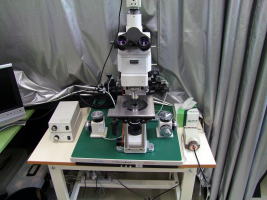
Optical microscopy with a manipulator
This device can move a TEM slice prepared with FIB. We also use this microscope to assemble a diamond anvil cell.
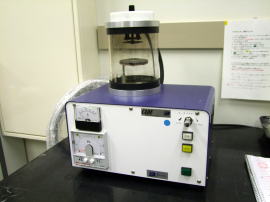
Carbon coating device
(Meiwafosis CADE-E)
This device can coat a thin carbon deposition on a sample. We use this device for pre-processing before electron microscopy observation.